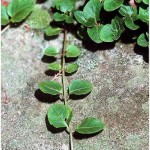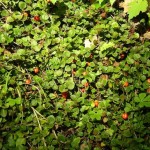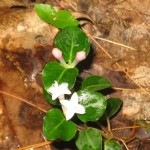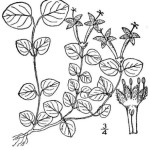Squaw Vine – Mitchella repens
|
Current Demand = Good |
Parts Used: Herb |
 |
 |
 |
 |
Family: Rubiaceae
Common Names: partridge berry, squaw berry, two-eyed berry, running fox,checker berry, deer berry, hill berry, wax cluster, box berry…
Description:
Squaw Vine is a perennial herbaceous woody shrub, that is an evergreen with a creeping non climbing vine. The leaves are opposite, ovate to cordate with a pale yellow midrib. The leaves remain green throughout the winter. The flowers are twin white tubular with 4 petals covered with fine hairs. The plant produces scarlet berries that are edible but tasteless. The fruit ripens in mid July through October. The twigs are very delicate and barely woody, light green to brown in color.
Planting/Cultivation:
Growing region: Squaw vine can be found from Maine to Florida, west to Texas and north to Minnesota. It is common in Pennsylvania to Georgia along the Appalachian regions. It is often found growing on rock bluffs, under shrubs and pine thickets as well as near the base of decaying timber.
The Squaw vine prefers acid soils under trees and large shrubs, in dappled shade with a rich moist soil. The plants are trailing and for new roots at the nodes of the vine.
Seed: it germinates better if given 3 months cold stratification and so it is best sown as soon as it is ripe in the autumn. Sow stored seed as early in the year as possible. Make sure that all the fruit pulp is removed from the seed because it contains germination inhibitors.
When they are large enough to handle, prick the seedlings out into individual pots and grow them on in the greenhouse for at least their first winter. Plant them out into their permanent positions in late spring or early summer, after the last expected frosts. See Harvesting/Drying NEXT
Harvesting/Drying:
Parts Used: herb
Squaw vine should be gathered in the spring or early fall for maximum potency. Gather the above ground parts of the vine only leaving the root system for future growth. Also be sure to leave a good portion (about one third) of the patch for seeding. If gathering in the fall, you should plant back existing berries approximately one half inch deep to promote future growth.
Make sure all foreign objects such as stones, grass or tree leaves and pine needles are removed. In a warm dry area such as a barn loft or attic place plants in a thin layer on a screen if possible. When drying any leaf or herb avoid the sunlight as this will bleach the color of your herbs and greatly decrease the value. When drying on a flat surface turning daily is recommended to speed the drying process and discourage mold and discoloring. Squaw vine tends to turn black when drying where heat and or airflow is lacking. Also spring discoloration is more common than with fall crops. Black colored leaves will bring less money than green color leaves.
Avoid combining fresh crops and dry or partially dry crops. When handling dried herbs take care to avoid crushing too many leaves. Keeping dried plants in tact will often increase the value of your crop.
The key to drying any root, herb or bark in an even combination of heat and airflow. Never use an oven or microwave.
Once your Squaw vine is completely dry place the herb carefully into a cardboard box, burlap or paper bag for storage in a dry area out of sunlight until you are ready to sell or use. Do not store the herb in plastic or it will mold.
Attributes (Images)
By Jomegat (Own work) [CC BY-SA 3.0 or GFDL], via Wikimedia Commons
 Root Buyer
Root Buyer